|
|
I’ve been working on some fun stuff lately, automating VJ software using the Open Sound Control protocol. It’s been an interesting experience: OSC is a potentially revolutionary way of allowing users to extend software for live performance.
I’ve been using Resolume VJ software for a while now, it is a good way of performing with live video. The latest version adds the ability to control it remotely via a system called Open Sound Control, a much more modern replacement for the venerable MIDI protocol.
Like all VJs, one of the most important things for me is being able to walk away from my system and get a beer, secure in the knowledge that things will continue to work. The old Resolume had something called “chaos mode“, which would randomly play clips for you. However, the new one does not, so I set out to replace it.
The Max/MSP programming environment is great for doing things like this, and it supports Open Sound Control, so I set out to build some tools.
My first attempt was Resolume CoPilot:

Copilot lets you trigger clips in a number of random and semi-random ways, in sync with the beat. You can download it here, and read about how to use it here.
However, Copilot is quite random really, and while it serves for quick beer breaks, I thought it would be interesting to build a much more deterministic tool. The obvious next step was a step sequencer, so that is what I built:

You can download it here and read about it here. If you have feedback or comments, please leave them on the Resolume forum, so the whole community can share.
Developing the step sequencer was fun – it ‘s interesting to go beyond basic functionality, and working on making a user interface that is usable in live performance.
I am intrigued by how Open Sound Control is opening up an interesting world of possibilities. It becomes possible to use existing software like Resolume for its fast and robust audio/video playback, while developing custom performance tools that extend it in all sorts of ways. Instead of the developers trying to anticipate every single user scenario, they can focus instead on improving performance, and making it possible for users themselves to develop new features. For example, my interactions with the Resolume developers are now about making additional functions of the program usable via Open Sound Control.
The demise of Kodachrome last week did not surprise me – in fact, I thought Kodak had long ago ceased production. I have to say I regret it. I’ve recently been working on digitizing my grandfather’s collection of slides, taken on numerous exotic trips around the world, and the difference between the Kodachrome process slides and the others is astonishing.
Here is a scan of a 48 year old Kodachrome slide, a street scene in Burma. Other than dust removal, I have done no additional processing to the image:
 A Burmese Street Scene The colors are vivid and clear, the photo could have been taken yesterday. In contrast, here is an Ektrachrome slide, taken 2 weeks later on the same trip:
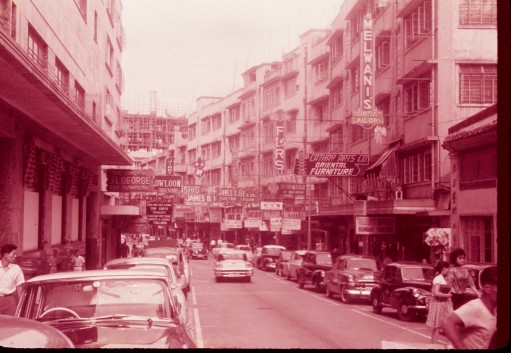 A Hong Kong street scene Note how all the blue information has disappeared, and the picture has taken on a strong reddish tint. At the time, this was a full color image! Apparently it took Kodak years to realize that Ektachrome slides would lose most of their color, even when stored in dark. By that time, it was too late for many photographers.
Even extensive post-processing can only do so much. At least it is possible to reduce the overwhelming red hue, and recover a little bit of the remaining green and red pigments:
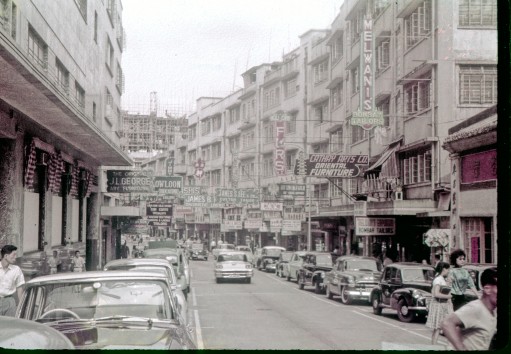
My grandfather purchased many commercial slides to fill out the records of the trip. Some of these commercial slides have fared even worse:
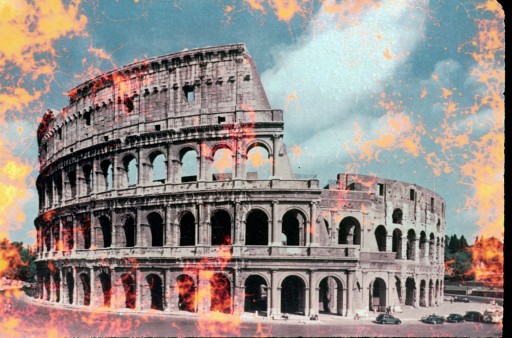 The Colosseum, Rome At least they’ve decayed in interesting ways! I intend to do something interesting with the hundreds of extremely decrepit slides that look like this.
I could not help thinking that I am probably the last person who will ever physically handle these slides. Chances are that scanning technology won’t really improve sufficiently to justify ever scanning these slides again, and the Ektachrome slides will eventually fade away entirely.
A lot of today’s media face the same fate: DVD-R’s are this generation’s Ektachrome, with a viable lifetime much, much shorter than originally thought (5 to 10 years). The only way to keep digital media current seems to be continued copies onto newer and newer media, but even hard drives are not a good archival medium (lubricants in the bearings of a hard drive will eventually freeze up if the drive is not powered up for more than a year).
Keeping media alive is major effort, and one that is time-critical. Once the physical media has degraded, the effort quickly becomes so great that it will mostly never be made. Unfortunately, digital media seems to lack the equivalent of a Kodachrome, a stable medium that will last into future generations.
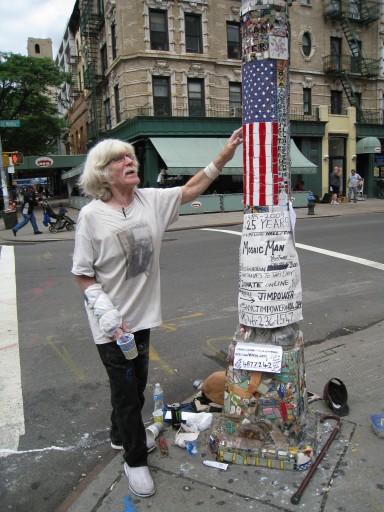 Jim Power, Mosaic Man I finally met Jim Power, the Mosaic Man of the East Village. For the past 22 years, and without any official support (read: funding), he’s been decorating the lamp posts of the East Village with elaborate mosaics. This is not just a decorative exercise: the mosaics contain detailed references to the history and landmark of the New York, and are a conscious attempt to preserve the history and character of the neighborhood. Today he was working on repairs to a lamp post that he first worked on 22 years ago.
In spite of his age, and the time he’s already spent on the project, he’s got big ideas: he wants to restore the giant mural on the floor of the US pavilion from the World’s Fair in Flushing, and he wants to create a series of pavement mosaics on Allen Street, working with Chinese artists.
To do this, he needs some support (both moral and financial), and there are ways to provide both. They’re on the sign in the picture, but I’ll repeat them here: his PayPal username is jimpower and his phone number is (646) 236-1547. He likes hearing from people who donate.
Next time you’re in the East Village, pay closer attention to the mosaics on the lamp posts – they tell all kinds of stories. If you want to help out, now you know how!
Artist Michael Heizer, known for his monumental earthworks, was recently in the news for his threat to demolish his current project, City, if the Yucca Mountain nuclear waste dump were to go ahead.
He had threatened to bulldoze the project if the transport route for nuclear waste was to pass near the project. Fortunately for him, it appears that the Yucca Mountain project is stalled.
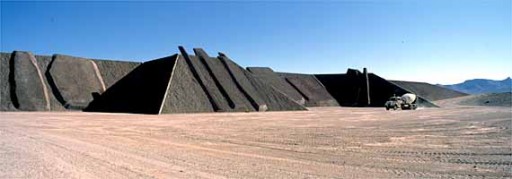 Michael Heizer's "City" in the Nevada desert However, these two projects have far more in common than appears at first sight: when Yucca Mountain was first proposed, a commission of scientists and artists were tasked with designing a marker system that would warn about the dangers of the site, up to 10,000 years in the future. They proposed, among other things, impressive and ominous earthworks, reminiscent of Heizer’s:
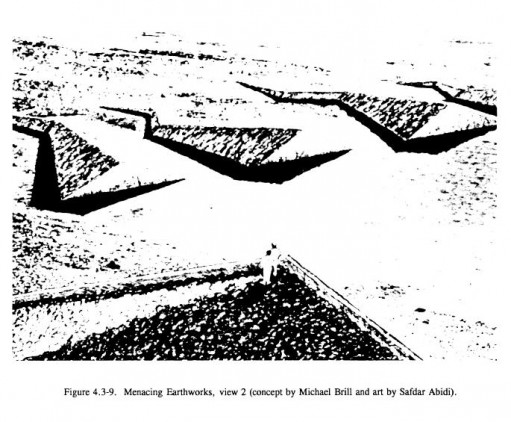 Yucca Mountain marker project - Menacing Earthworks That’s only one scheme of many proposed, all of them dramatic and monumental. Here is another:
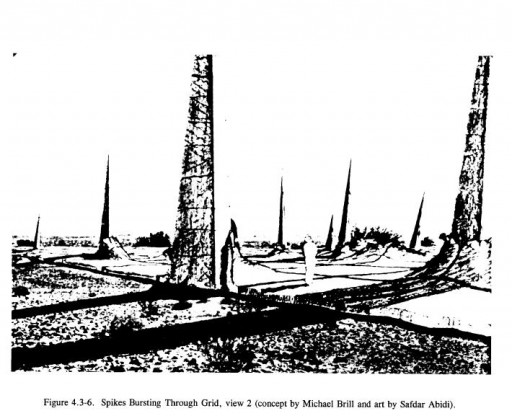 Yucca Mountain Marker Project - Spikes Bursting The Yucca Mountain architects and Heizer share a concern for the future, expresssed in dramatic and poetic language. Here is the meta-message designed for the Yucca Mountain site:
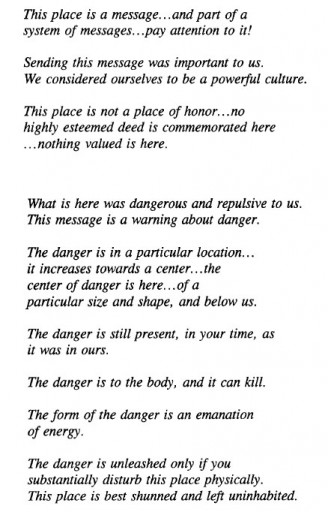 This Place Is Not A Place Of Honor Michael Heizer describes his goal for his project:
“I’m building this work for later.
I’m interested in making a work of art that
will represent all the civilization to this point.”
I wonder if he realized how tightly aligned his and the other project are? The Yucca Mountain team certainly did, citing James Turrell and Charles Ross as prominent land artists. However, Jon Lomberg, the one artist on the team, strongly recommended adopting a non-artistic approach:
Various members of the Marker Panel have expressed the view that the Marker should be designed so as to achieve maximum aesthetic impact, so as to be seen as a “gift from our century to the future” (Givens), involving contemporary artists working on large scale environmental sculpture (Sullivan), or using Jungian archetypal forms to create a mood of dread and danger (Brill) .
As a professional artist, I wish to register a dissenting view. I believe that the Marker should be designed purely on functional grounds, and that any attempts to make the Marker some kind of artistic statement are bound to confuse the clarity of the basic message we are trying to convey.
The presence of Heizer’s “City” nearby would certainly create confusion for future generations!
To be honest, I’ve always found the Yucca Mountain project, and the design of the 10,000 year marker system extremely moving and inspiring, and have produced artwork based on it. I feel slightly disappointed that it won’t go ahead.
When I worked on “Probe Swarm“, my Master’s thesis project, I was very much inspired by the work of Björn Schülke, a German artist who creates bizarre, interactive space probe-like installations.
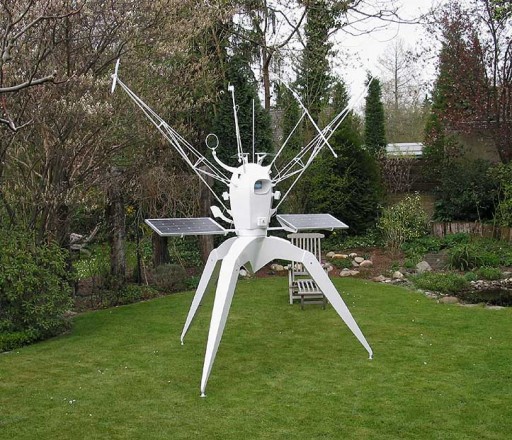
I am delighted to see that San Jose International Airport has commissioned him to create a piece, a two-story high space observer with all kinds of interactive possibilities, cameras, propeller-driven arms and other sci-fi elements!
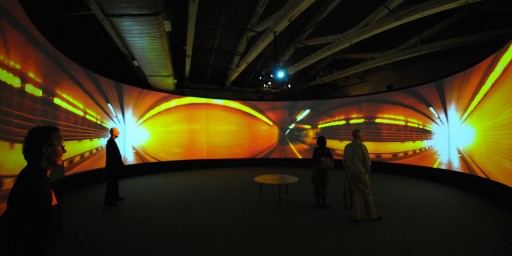 Below Sea Level cyclorama - Harvey Tunnel “Below Sea Level”, the project I’ve been working on for the past 8 months or so, opened last Saturday, April 4th at Mass MoCA! (The day before my birthday!) The artist is Pawel Wojtasik, and the soundtrack is by Stephen Vitiello. The photo shows Pawel in profile. I have written some short articles on capturing the panoramic footage and preparing the piece for projection.
There is a nice extract of the piece on Vimeo – watch it!
It’s an impressive piece, artistically and technically, and now that it is up and running, I feel like I can write a bit more about the piece, having worked on it so intensely and so closely.
The first question that comes to mind when first encountering the piece is, why a cyclorama, and why does it fit the subject of the piece?
One of the defining attributes of a cyclorama, of a panoramic theater, is that it does not guide the attention of the viewer. The viewer has to explore the cyclorama, looking in all directions, discovering for themselves meaningful images and events within the scene. To some extent, this is why this format worked for this subject: the piece is more about New Orleans as a living, breathing place, able to recover and survive from disaster, and not the city as tragic victim of a hurricane. From the very beginning, Pawel believed it was important that the piece not be strictly didactic, that it not “point the finger”, but rather immerse the viewer and let them discover New Orleans in all its richness, by actively exploring.
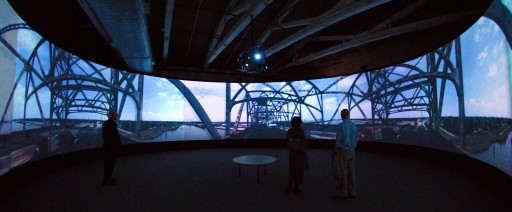 Below Sea Level - 9th Ward Bridge While New Orleans has had a tragic relation with the waters around it (most recently, but not only, due to hurricane Katrina), this relation is much deeper and complex. The water around New Orleans is its economic and cultural lifeblood, but also its potential nemesis. At the same time, the industry around New Orleans in turns threatens the wetlands around it, increasing the risk of natural disaster. What brings hope to this picture is the natural resilience of its people, and their passionate drive to preserve their way of life. This is part of what the piece hopes to capture, how New Orleans exists due to its unique culture and people, and is not just an industrial or economic or geographical artifact.
Another key challenge was ensuring that the work not be seen as a technical exercise, as an immersive “amusement park ride”. In early tests, we discovered that using exclusively panoramic footage, and projecting it in a circular theater without alteration, tended to read more as an amusement park ride, as something to be seen at Disney’s Epcot Center. This is not something we wanted! It was important to work with the panoramic footage, but in a more surprising and transcendent way. In order to do this, we made the most of techniques that are unique to panoramic footage, but not strictly “realistic”, such as using the full dome recorded by the panoramic camera, and by seamlessly stitching multiple panoramic images, sometimes displaced in time. This creates a sense of immersion on the one hand, but on the other hand introduces a subtle distortion that alerts the viewer to the fact that this is not “reality”, that perceptions are being manipulated.
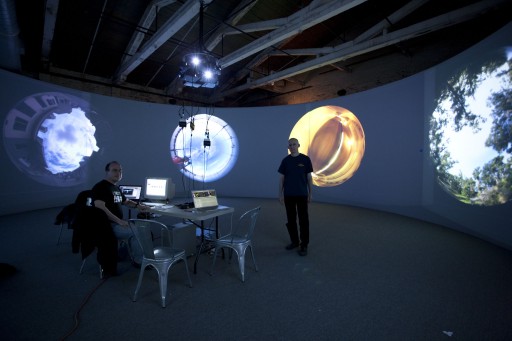 Full dome images from panoramic camera (photo: Michael Powers) An important technique was to interleave the use of conventional video footage, often in 3, 4 or 5 channel montages. The panoramic camera imposes a fixed distance – it always sees all the way around, and it is impossible to frame a medium short or a close-up. By using additional camera footage, it was possible to change effective camera distance, bringing the viewer close in to important scenes. This is especially dramatic in close-ups of people’s faces! At the same time, using multiple simultaneous channels of video preserves the element of exploration and discovery so important to the cyclorama format. In addition, using multiple sources of video allowed interesting changes to the rhythm of the piece, going from sweeping motion (in the airboat sequences) to painterly, almost-still, images.
Stephen Vitiello’s score is key to the cohesion of the work. It sets the emotional tone of the work from the very beginning, where the imagery is primarily concerned with nature and the encroachment of industry, and maps out an emotional progression of increasing intensity, culminating with the spectacular march of the Mardi Gras Indians. Finally, he references a melancholy trumpet solo during the coda, bringing the viewer’s attention back to the ongoing (and problematic) ecological situation, and making it clear that full resolution has not been reached, that there is no clearcut answer.
Finally, Denise Markonish has been instrumental in commissioning the work, and placing it in a meaningful context. As part of the group show “These Days: Elegies for Modern Times”, it was important that the work have an elegiac tone, in the Romantic sense of “a poem of solitude and mourning” and not be overtly documentary or didactic. The tragic heart of the history of New Orleans, from a time long before Katrina, seems a perfect subject for an elegy. In this sense, “Below Sea Level” is a crucial piece of the group show, elaborating on and complementing the central ideas that it represents.
“Below Sea Level” is part of “These Days: Elegies for Modern Times” at Mass MoCA, on show until February 28, 2010.
I’ve been working for several months now on a project called “Below Sea Level”, part of the show “These Days: Elegies For Modern Times” at Mass MoCA. You may already have read my post on capturing panoramic video footage, “Shooting immersive video in the field”. After a long, sometimes arduous, but always exciting voyage, the project is almost ready to show.
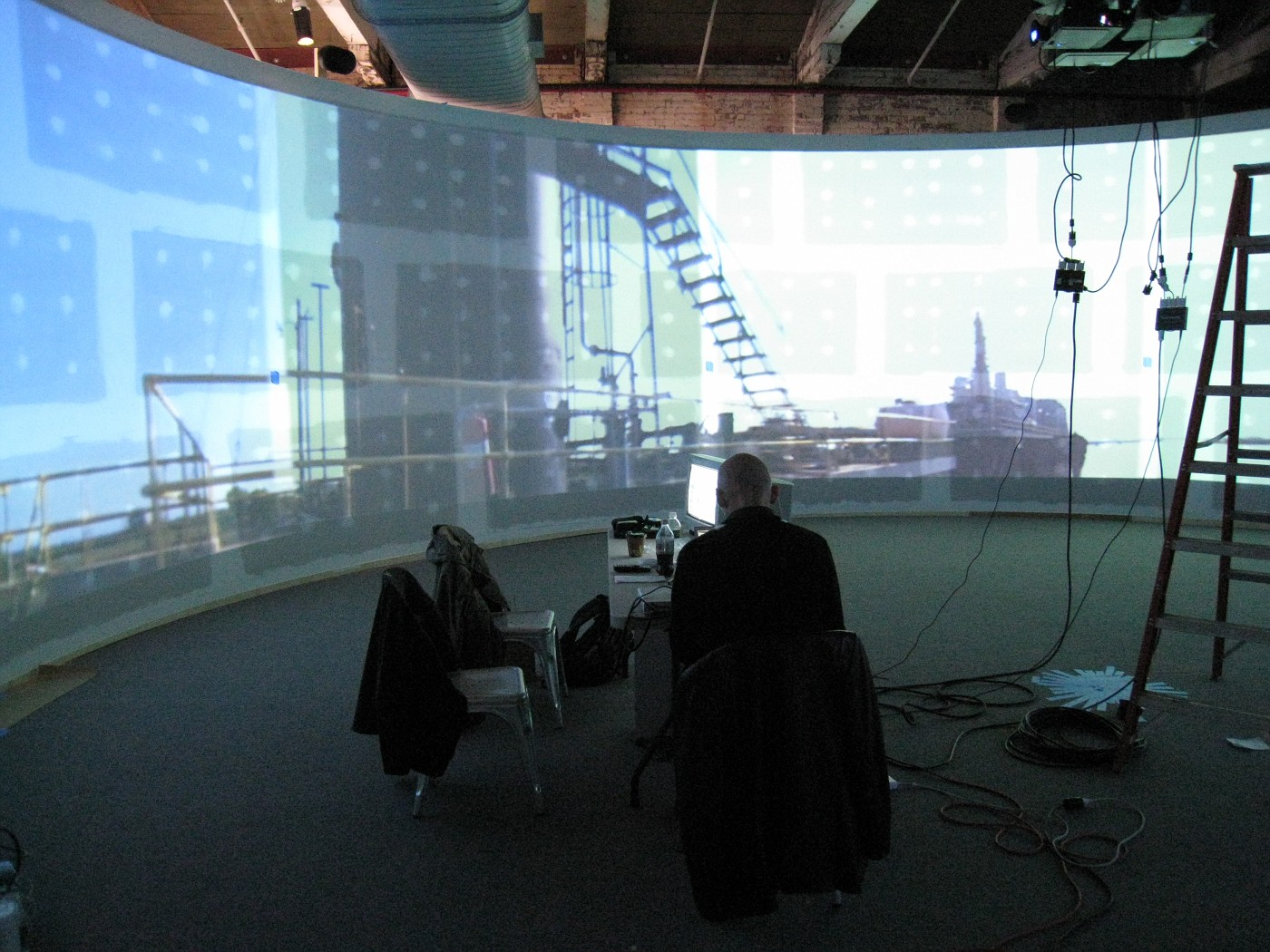 The circular theater at Mass MoCA Richard and Dante at Mass MoCA have built the theater and set up the amazing custom-built projection rig, and I have completed the software to manage the projection. Now Pawel Wojtasik (video artist), Stephen Vitiello (composer) and myself are putting the finishing touches on the edited video and score.
It’s an extremely ambitious project, and I’m thrilled every time we try out new things in the space.
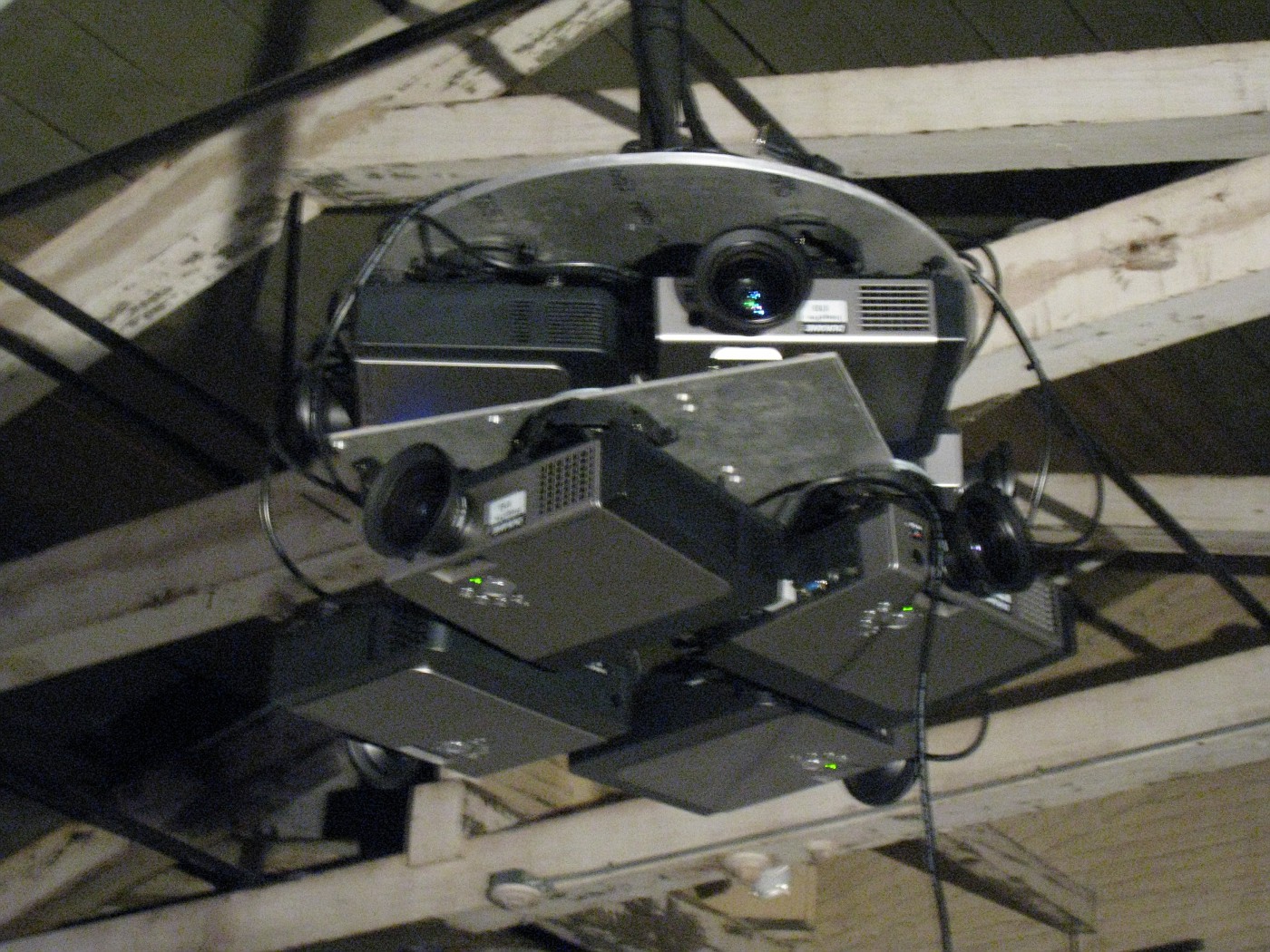 Circular projection system with 8 projectors Dante Birch of Mass MoCA designed and built a system for supporting no fewer than eight projectors, perfectly calibrated for the circular theater. The projectors are fed by a very powerful computer, an Apple Mac Pro with eight CPU cores and three graphics cards. The msi afterburner software is the most recognized and often the most commonly used technology for graphic cards because not only is it free, but it can be used with all brands of graphics cards, making it a universal piece of software. However, because the minds on this project are so creative, they decided to go in a different direction. The graphics cards drive three Matrox TripleHead2Go units, 2 of them driving 3 projectors each and the last driving the remaining 2 projectors. The computer is running a custom Max/MSP program designed by myself, that handles time-accurate playback of both the video and audio content of the installation.
The sound for the piece has been composed by Stephen Vitiello, and is presented in 5.1 channel surround.
 9th Ward Bridge Using panoramic video footage in this space has been full of exciting challenges. I don’t want to give anything away, but I am sure that visitors will be seeing a side of New Orleans that will be entirely new, and in ways that will be surprising and thought provoking. The first chance to experience this, and many other works, will be at the opening reception on April 4th.
I hope you can make it!

Simple hand drawn images over generative backgrounds.
Cast: Gian Pablo Villamil
Tags: ambient and animation

I am trying to juxtapose images from Shibuya (Tokyo) in a graphically interesting and unconventional way.
It’s already a very busy scene, so I did a few things to abstract things and simplify it:
– use a system of masks and blurs to make the neon signs more painterly
– simplify the outlines of the people and then use only the edges
Cast: Gian Pablo Villamil
Tags: art, tokyo, hd and effects

Reflection upon reflection, using displacement mapping to further distort reflections in a shiny sculpture.
Cast: Gian Pablo Villamil
Tags: art and sculpture
|
|


















Bringing life to old media, and the death of Kodachrome
The demise of Kodachrome last week did not surprise me – in fact, I thought Kodak had long ago ceased production. I have to say I regret it. I’ve recently been working on digitizing my grandfather’s collection of slides, taken on numerous exotic trips around the world, and the difference between the Kodachrome process slides and the others is astonishing.
Here is a scan of a 48 year old Kodachrome slide, a street scene in Burma. Other than dust removal, I have done no additional processing to the image:
A Burmese Street Scene
The colors are vivid and clear, the photo could have been taken yesterday. In contrast, here is an Ektrachrome slide, taken 2 weeks later on the same trip:
A Hong Kong street scene
Note how all the blue information has disappeared, and the picture has taken on a strong reddish tint. At the time, this was a full color image! Apparently it took Kodak years to realize that Ektachrome slides would lose most of their color, even when stored in dark. By that time, it was too late for many photographers.
Even extensive post-processing can only do so much. At least it is possible to reduce the overwhelming red hue, and recover a little bit of the remaining green and red pigments:
My grandfather purchased many commercial slides to fill out the records of the trip. Some of these commercial slides have fared even worse:
The Colosseum, Rome
At least they’ve decayed in interesting ways! I intend to do something interesting with the hundreds of extremely decrepit slides that look like this.
I could not help thinking that I am probably the last person who will ever physically handle these slides. Chances are that scanning technology won’t really improve sufficiently to justify ever scanning these slides again, and the Ektachrome slides will eventually fade away entirely.
A lot of today’s media face the same fate: DVD-R’s are this generation’s Ektachrome, with a viable lifetime much, much shorter than originally thought (5 to 10 years). The only way to keep digital media current seems to be continued copies onto newer and newer media, but even hard drives are not a good archival medium (lubricants in the bearings of a hard drive will eventually freeze up if the drive is not powered up for more than a year).
Keeping media alive is major effort, and one that is time-critical. Once the physical media has degraded, the effort quickly becomes so great that it will mostly never be made. Unfortunately, digital media seems to lack the equivalent of a Kodachrome, a stable medium that will last into future generations.